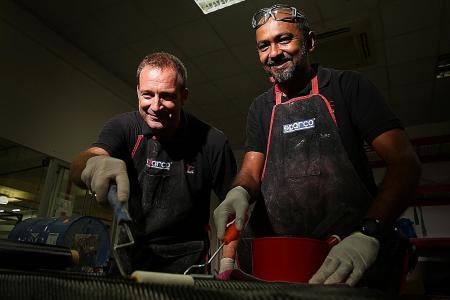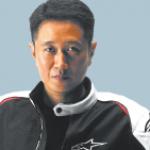Meet the head chefs of carbon fibre in the motorsport arena
In their "kitchen", ingredients are neatly arranged on the table.
They don aprons and gloves so as not to contaminate those precisely cut shapes.
Depending on what they are serving, they will brush a layer of special glaze before the "dish" goes into an oven.
In another time and place, Mr Matthew Keith Wilkinson and Mr Ashok Kumar may have been chefs in the culinary world.
At Singapore-based engineering company Hope Technik's composite workshop, the duo instead cook up a feast in the eyes of motorsport and aviation fans.
Their speciality? Fabricating carbon fibre panels and parts that are worthy of being works of art, strong and light for use in the aviation, military or motorsport industries.
Mr Ashok, 40, production operations manager of Trigen Automotive, a special application vehicle business arm of Hope, said making components out of carbon fibre is "exactly the same" as cooking.
Both bikers are used to working with composites such as glass fibres and ABS plastics, including black gold, a term reserved for carbon fibre.
The processes vary from compression moulding, injection moulding and oven-cooking to dealing with pre-impregnated fibres and light resin transfer molding.
"As with everything, carbon comes in different qualities and properties," said Mr Wilkinson, 45, head of composite at Hope.
"People want carbon fibre as long as it is black, has the herringbone design, and they are happy. Whether it is strong and lightweight, they don't care."
But for discerning motorcycle race teams with deep pockets, looks matter less than strength.
They look for attention to detail and the engineering behind bikes like the BMW HP 4 Race, which is not street legal and has a limited production run of 750.
Both the effort and equipment used to build a HP 4 Race's carbon fibre chassis, fairing and wheels are long and complex.
The process is also expensive due to the patented and proprietary technologies used, which ultimately drives up the HP 4's estimated price to about $160,000.
In return, you get a 215bhp, 146kg (dry weight) cruise missile.
But how strong are components made out of carbon fibre?
Mr Ashok, who has flown in a full-carbon Red Bull Air Race airplane, said: "The wing span of a Red Bull Air Race plane can take a 20g loading and can flex about 1.5m."
Yet, there are drawbacks, said Mr Wilkinson, who rides a BMW F850GS.
If left under the sun and without a UV-filter clear coat, carbon fibre components will turn dark yellow.
Unlike metals, which may show signs of stress or bending when under heavy loads, flaws in carbon fibre panels are harder to detect.
Mr Wilkinson said: "There is no way to tell when it (the carbon fibre part) is going to break. There are no warning signs. With carbon, when it goes beyond its limits, it snaps."
This is why there are stringent checks and high standards for carbon fibre parts used in the aviation industry, where everything has to be exact, said Mr Wilkinson, who used to work in aviation.
FOLLOW @BIKERBOY_TNP ON INSTAGRAM FOR MORE ADVENTURES
Get The New Paper on your phone with the free TNP app. Download from the Apple App Store or Google Play Store now



